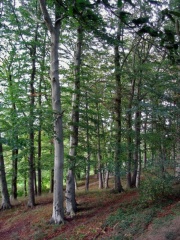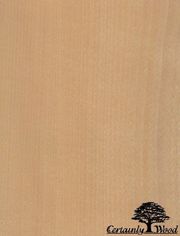Difference between revisions of "European beech"
m (Text replace - "== Authority ==" to "== Sources Checked for Data in Record ==") |
|||
| Line 1: | Line 1: | ||
| − | [[File:BeechesF5.jpg|thumb|European beech | + | [[File:BeechesF5.jpg|thumb|European beech ''Fagus sylvatica'']] |
| − | |||
| − | ''Fagus sylvatica'']] | ||
== Description == | == Description == | ||
| Line 10: | Line 8: | ||
''Fagus sylvatica''; Almindelig Bøg (Dan.); Rotbuche (Deut.); haya (Esp.); hêtre (Fr.); beuk (Ned.); Buk zwyczajny (Pol.); Bok (Sven.); faia (Port.); faggio (It.); beechwood; common beech | ''Fagus sylvatica''; Almindelig Bøg (Dan.); Rotbuche (Deut.); haya (Esp.); hêtre (Fr.); beuk (Ned.); Buk zwyczajny (Pol.); Bok (Sven.); faia (Port.); faggio (It.); beechwood; common beech | ||
| − | [[File:EuroBeechnutf5.jpg|thumb|European beech | + | [[File:EuroBeechnutf5.jpg|thumb|European beech ''Fagus sylvatica'']] |
| + | [[File:beechwc.jpg|thumb|Beech (''Fagus sylvatica'')]] | ||
| + | == Risksy == | ||
| − | + | Skin contact and dust inhalation may cause irritation and allergies. Highly acidic. May evolve volatile organic acids. | |
| − | == | + | == Physical and Chemical Properties == |
Large trees growing to 35 m. Bark=smooth, gray. Leaves=simple with veins and toothed edges. Fruit=Large husk containing 2 shiny brown edible nuts. | Large trees growing to 35 m. Bark=smooth, gray. Leaves=simple with veins and toothed edges. Fruit=Large husk containing 2 shiny brown edible nuts. | ||
| Line 25: | Line 25: | ||
|} | |} | ||
| − | == | + | == Sources Checked for Data in Record == |
| − | + | * Schoch, W., Heller, I., Schweingruber, F.H., Kienast, F., 2004: [http://www.woodanatomy.ch/ Wood anatomy of central European Species]: Beech, [http://www.woodanatomy.ch/species.php?code=FASY Fagus sylvatica L.] | |
| − | |||
| − | + | * Alden Identification Services, Microscopic Wood Identification: [https://wood-identification.com/wood-types/ Link] | |
| − | |||
| − | |||
| − | |||
| − | |||
| − | |||
| − | |||
| − | |||
| − | |||
| − | |||
| − | |||
| − | |||
| − | * | + | * Virginia Tech Dendrology website at www.fw.vt.edu/dendro/dendrology/main.htm (accessed Oct. 8, 2005) |
| − | * Wikipedia | + | * Wikipedia: http://en.wikipedia.org/wiki/European_Beech (Accessed Oct. 8, 2005) |
* F. H. Titmuss, ''Commercial Timbers of the World'', The Technical Press Ltd., London, 1965 | * F. H. Titmuss, ''Commercial Timbers of the World'', The Technical Press Ltd., London, 1965 | ||
Revision as of 12:25, 3 September 2020
Description
A large, deciduous tree, Fagus sylvatica, native to northern Europe. Beech trees have a smooth gray bark and a hard, heavy wood. European beech trees are often grown in large hedgerows. The reddish-brown, close-grain beechwood bends well and gives a smooth shiny finish. Beech is a commonly used timber for flooring, cabinetry, furniture, veneer, tool handles, and turnery. It was occasionally used in panel paintings in western Europe.
Synonyms and Related Terms
Fagus sylvatica; Almindelig Bøg (Dan.); Rotbuche (Deut.); haya (Esp.); hêtre (Fr.); beuk (Ned.); Buk zwyczajny (Pol.); Bok (Sven.); faia (Port.); faggio (It.); beechwood; common beech
Risksy
Skin contact and dust inhalation may cause irritation and allergies. Highly acidic. May evolve volatile organic acids.
Physical and Chemical Properties
Large trees growing to 35 m. Bark=smooth, gray. Leaves=simple with veins and toothed edges. Fruit=Large husk containing 2 shiny brown edible nuts.
Wood is acidic. Color: Pinkish brown with dark brown rays. Rings: obscure. Pores: diffuse, fine. Grain: faint. Rays: distinct. Hard, strong and heavy. Specific gravity = 0.7-0.9
| Density | 45-55 ppcf |
|---|
Sources Checked for Data in Record
- Schoch, W., Heller, I., Schweingruber, F.H., Kienast, F., 2004: Wood anatomy of central European Species: Beech, Fagus sylvatica L.
- Alden Identification Services, Microscopic Wood Identification: Link
- Virginia Tech Dendrology website at www.fw.vt.edu/dendro/dendrology/main.htm (accessed Oct. 8, 2005)
- Wikipedia: http://en.wikipedia.org/wiki/European_Beech (Accessed Oct. 8, 2005)
- F. H. Titmuss, Commercial Timbers of the World, The Technical Press Ltd., London, 1965
- G.S.Brady, Materials Handbook, McGraw-Hill Book Co., New York, 1971 Comment: p. 93
- Hermann Kuhn, Conservation and Restoration of Works of Art and Antiquities, Butterworths, London, 1986
- Caring for your Collections, Arthur W Schulz (ed.), Harry N. Abrams, Inc. , New York, 1992
- Michael McCann, Artist Beware, Watson-Guptill Publications, New York City, 1979
- George Savage, Art and Antique Restorer's Handbook, Rockliff Publishing Corp, London, 1954
- Pam Hatchfield, Pollutants in the Museum Environment, Archetype Press, London, 2002


